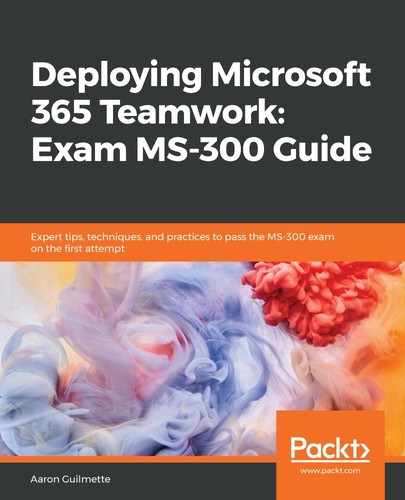A Teams meeting policy controls what meeting features are available before, during, and after meetings. Teams meeting policies can be configured per-user, per-organizer, or a combination (per-user and per-organizer). As with app policies, meeting policies can be assigned to users.
To create or edit a meeting policy, use the following procedure:
- Navigate to the Microsoft Teams admin center (https://admin.teams.microsoft.com) and select Meetings | Meeting policies:

- Click + Add to create a new meeting policy or select an existing policy to modify. Note: Only the default Global policy can be modified. All other default policies are read-only:

- Enter a name and description for the policy.
- Select the policy options and then click Save:

Use the following table as a guide for the setting options for meeting policies:
| Setting | Per-User | Per-Organization | Description |
| General/Allow Meet now in channels | X | This controls whether a user can start an ad hoc meeting in a Teams channel. | |
| Allow private Meet now (preview) | X | This controls whether a user can start an ad hoc private meeting. | |
| General/Allow the Outlook add-in | X | This determines whether a user can schedule a Teams meeting from within Outlook (Windows, Mac, or mobile clients). | |
| General/Allow channel meeting scheduling | X | This controls whether a user can schedule a meeting in a Teams channel. | |
| General/Allow scheduling private meetings | X | This controls whether a user can schedule a private meeting in Teams (outside of a channel). | |
| Audio and video/Allow transcription | X | X | This controls whether captions and transcription are available during the playback of recorded meetings. If disabled for a user, they will not be able to enable transcription. |
| Audio and video/Allow cloud recording | X | X | This controls whether a user's meetings can be recorded. Meetings can be recorded if the participant initiating the recording has the feature enabled AND is an authenticated user in the same organization. External guests cannot record meetings. |
| Audio and video/Allow IP video | X | X | This controls whether video can be used in meetings hosted or started by a user. If the meeting is organized by someone with this policy, video sharing is enabled if the meeting participants also have the policy enabled. External users or users without a policy assigned inherit the meeting organizer's setting. If a participant has this setting disabled and attends a meeting organized by someone who has it enabled, the participant can see the video that is shared by others but is unable to share their own. |
| Audio and video/Media bit rate (KBs) | X | This controls the media bit rate for audio and video used in meetings. | |
| Audio and video/Enable live captions (preview) | X | This controls whether users can select Turn on live captions during a meeting. | |
| Content sharing/Screen sharing mode | X | X | This controls what desktop or window sharing is allowed in a meeting. Options include Entire screen, Single application, and Disabled. Meeting participants (including external participants) without an assigned policy inherit the policy of the meeting organizer. |
| Content sharing/Allow a participant to give or request control | X | This controls whether a user can grant control of a shared desktop or window to others in a meeting. If the setting is disabled, the Give control option is grayed out. | |
| Content sharing/Allow an external participant to give or request control | X | This controls whether an external user can grant control of a shared desktop or window to others in a meeting. If the setting is disabled, the Give control option is grayed out. | |
| Content sharing/Allow PowerPoint sharing | X | This controls whether a user can share PowerPoint decks during a meeting. The PowerPoint presentation is uploaded to the meeting. External users inherit the setting of the meeting organizer. | |
| Content sharing/Allow whiteboard | X | This controls whether a user can share a whiteboard during a meeting. External users inherit the setting of the meeting organizer. | |
| Content sharing/Allow shared notes | X | This controls whether a user can create and share notes in a meeting. External users inherit the setting of the meeting organizer. Note: The Meeting notes tab is only available in meetings with 20 or fewer participants. | |
| Participants and guests/Let anonymous people start a meeting | X | This per-organizer setting controls whether anonymous users can join a meeting without an authenticated user from the meeting organizer's organization joined. | |
| Participants and guests/Automatically admit people | X | This per-organizer setting controls whether people can join a meeting directly or if they will wait in the lobby. Possible values including Everyone, Everyone in your organization and federated organizations, and Everyone in your organization. | |
| Participants and guests/Allow dial-in users to bypass the lobby | X | This per-organizer policy controls whether people who dial in by phone can bypass the lobby, regardless of the Automatically admit people setting. | |
| Participants and guests/Allow Meet now in private meetings | X | This controls whether Meet now is available in private meetings. | |
| Participants and guests/Enable live captions | X | This controls whether users can enable live captions in a meeting. | |
| Participants and guests/Allow chat in meetings | X | This controls whether chat is available in meetings. |
Next, we'll learn about configuring phone numbers for users.
